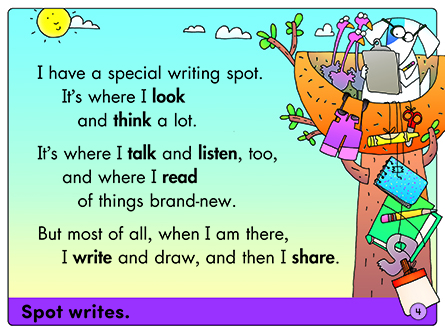Page 4 from

Young children are eager to share their ideas and stories. It’s important that they find a receptive audience for their communicating—talking, drawing, and especially their earliest writing efforts. Because children come to the classroom with a diversity of experience and skills, it’s helpful to introduce the learning process with a likable, neutral character they can all identify with—Spot. Children may memorize and sing this rhyme. It reinforces the steps in the process—not just the process of learning to write, but that of learning to do most anything.
About the Picture Spot demonstrates the fun of having a special place to gather writing supplies. He also has a great command post for looking around and thinking as he writes.
Major Concepts
- Writers need to think about what they want to share.
- Writers need to talk and listen as they prepare to share.
- Writers need tools to communicate.
- Early writers communicate with pictures and words.
- The heart of the writing process is a meaningful message.
- All writing needs an audience.

Young children are eager to share their ideas and stories. It’s important that they find a receptive audience for their communicating—talking, drawing, and especially their earliest writing efforts. Because children come to the classroom with a diversity of experience and skills, it’s helpful to introduce the learning process with a likable, neutral character they can all identify with—Spot. Children may memorize and sing this rhyme. It reinforces the steps in the process—not just the process of learning to write, but that of learning to do most anything.
About the Picture Spot demonstrates the fun of having a special place to gather writing supplies. He also has a great command post for looking around and thinking as he writes.
Major Concepts
- Writers need to think about what they want to share.
- Writers need to talk and listen as they prepare to share.
- Writers need tools to communicate.
- Early writers communicate with pictures and words.
- The heart of the writing process is a meaningful message.
- All writing needs an audience.